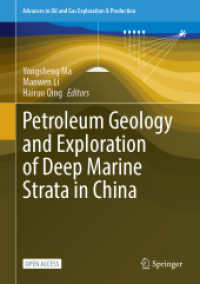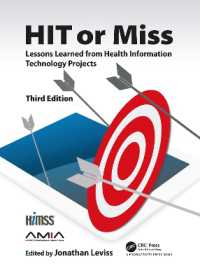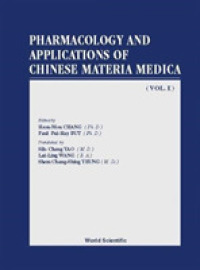- ホーム
- > 洋書
- > 英文書
- > Science / Mathematics
Full Description
This book focuses on cold habitat microbes as a potential source of elite enzymes and secondary metabolites to meet the growing demands of the pharmaceutical, food and biotechnological industries. Microbes living in such extremely cold conditions are reported to produce various biomolecules with potential biotechnological applications.
The book overviews recent research trends to discover such important biomolecules and also suggests future research directions to discover such elite novel biomolecules.
Salient features:
Covers studies on various biotic communities and abiotic components of the soil of terrestrial habitats with a focus on cold habitats
Discusses various 'Omic' approaches: metagenomics and meta-transcriptomics
Lists adaptation strategies adopted by cold-adapted microbes
Highlights various biotechnological and industrially important biomolecules produced by cold-adapted microbes
Explores the role of microbial biofilm in the degradation of microplastics in cold habitats
Contents
1. Soil physicochemical and biological properties in cold habitats of the north-west Himalayas: Their constraints and management strategies 2. Soil as a host to the biotic community 3. Effects of soil characteristics on the diversity and biomass of microbial communities 4. Soil microbiome of cold deserts and its biotechnologically useful adaptations for life on Earth and beyond, with a detailed case study on the Atacama Desert microbiome 5. Phosphorous, potassium and iron solubilising bacteria in trans-Himalayan soil 6. Potential and responses of microfungi to the dynamics of cold environments 7. Rhizobiome of the Indian Himalayan ecosystem and its role 8. Soil microbiome for enhanced crop productivity 9. Impact of microbial biofilm community shifts on the degradation of microplastics in cold habitats 10. A review on the bioprospection of psychrophilic bacteria and their potential applications for sustainability 11. Psychrophilic soil microorganisms: A potential source of secondary metabolites 12. Brass tacks of 'Omics' technologies for decoding soil microbiome 13. Ecological role of psychrophiles and mechanism of adaptation in various cold ecozones 14. Ecology and remediation of soil: The steps toward modern soil biotechnology 15. Machine learning to explore the psychrophilic soil microbiome 16. Mass spectrometry as an emerging analytical technique for agriculture under changing climate








